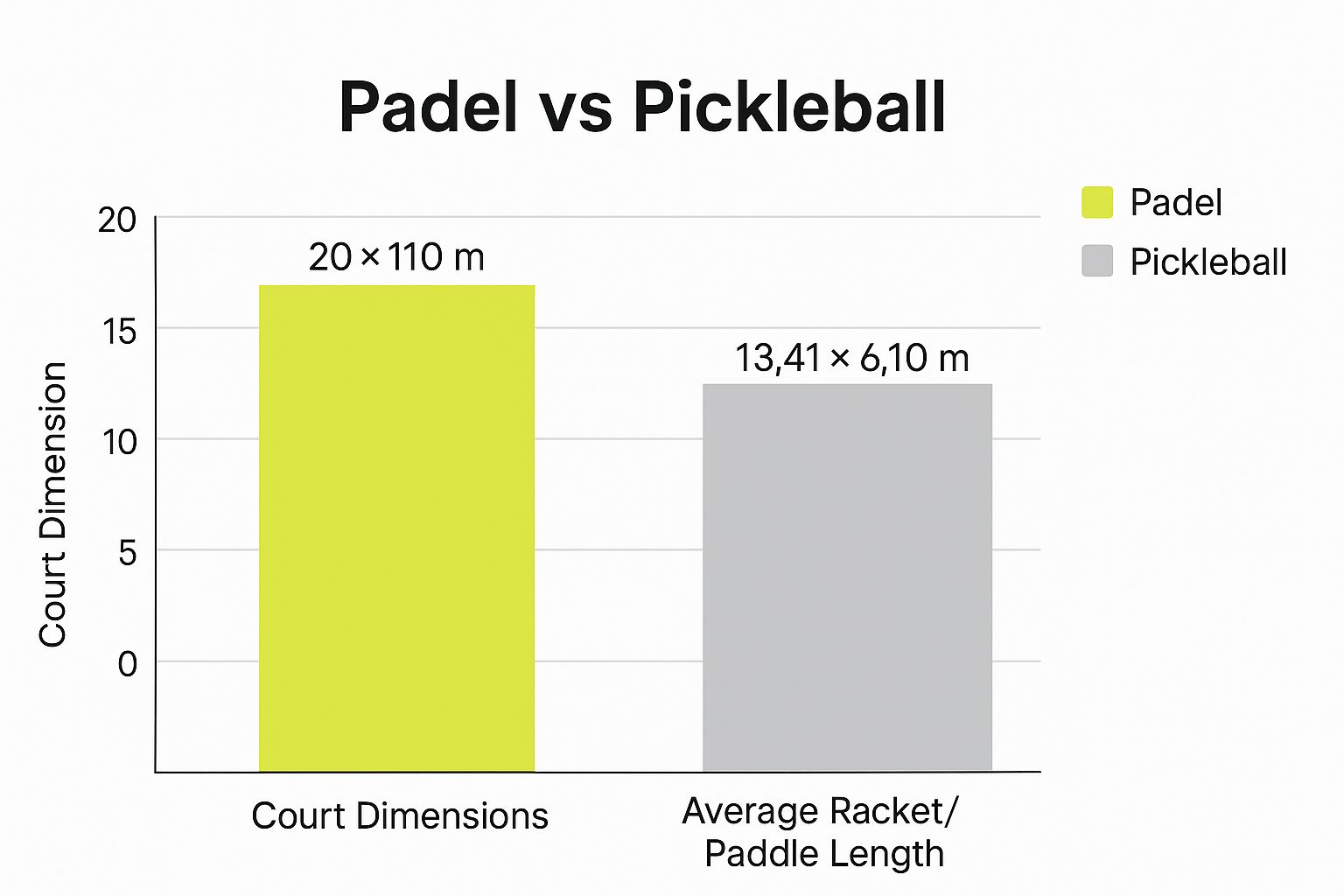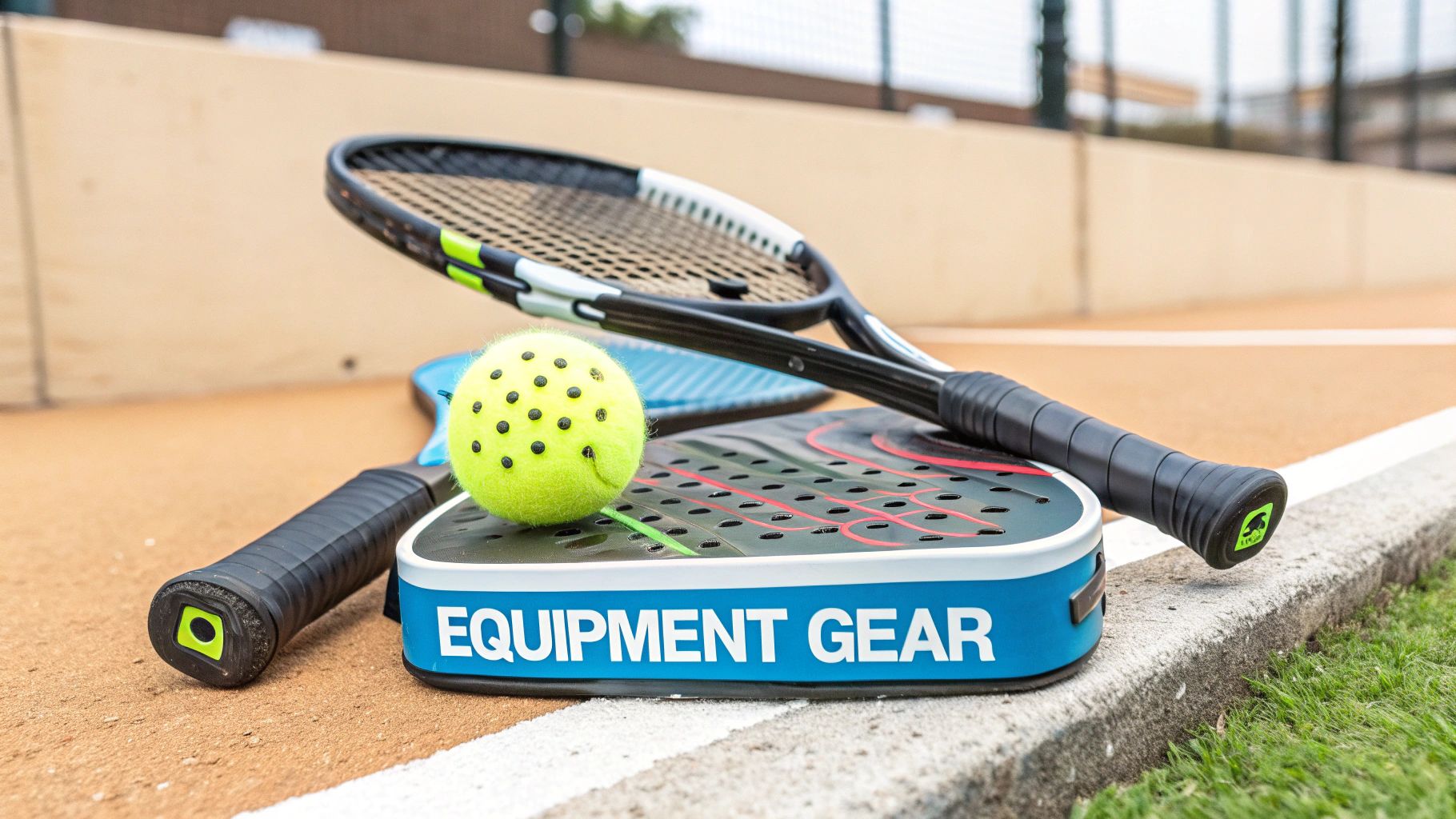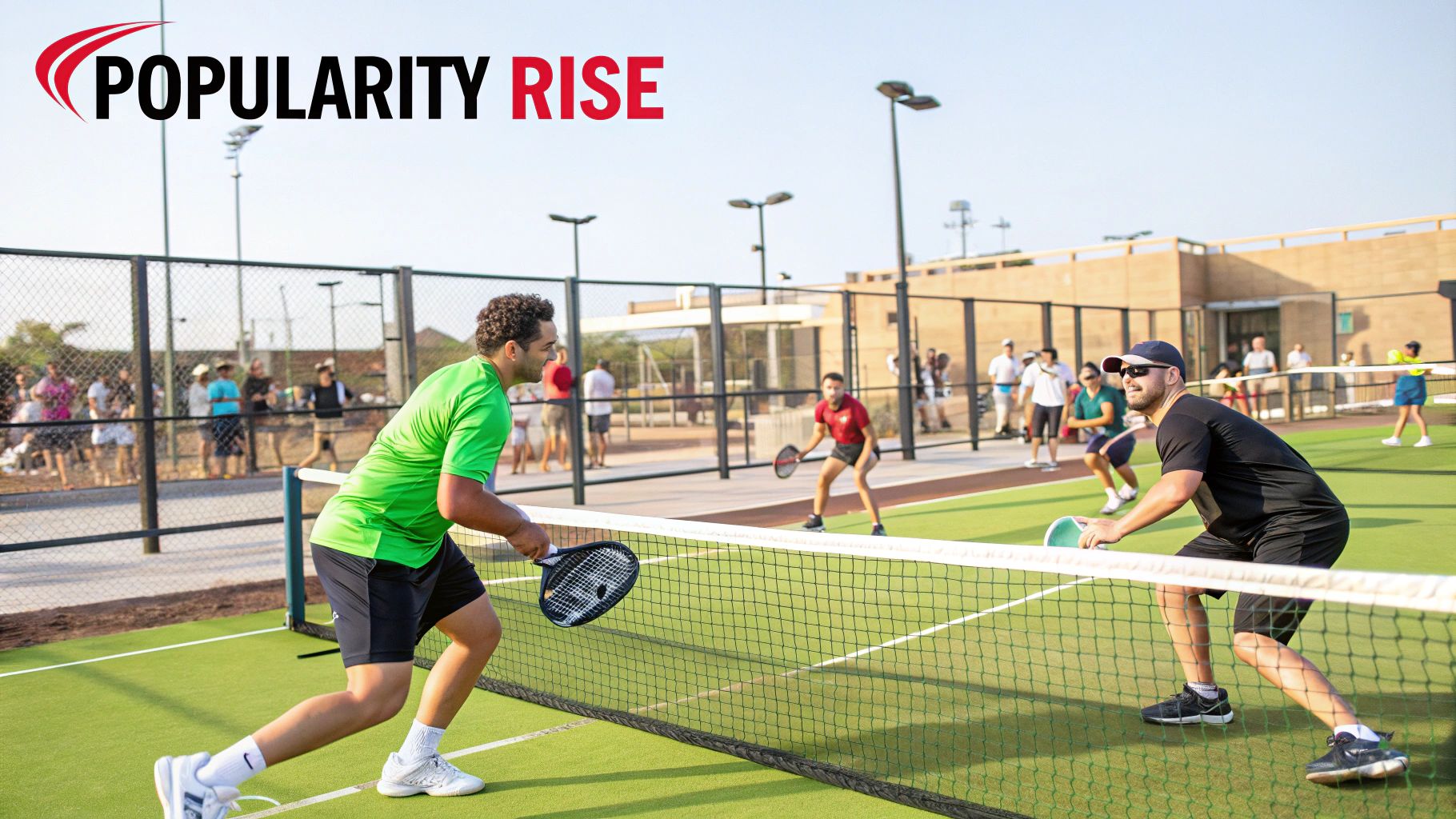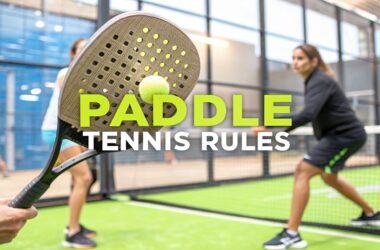So, you're wondering if padel and pickleball are the same thing. The short answer is no, not at all. While they’re both fun, social, and much more approachable than tennis, they are fundamentally different sports with their own unique courts, rules, and gear.
People often get them mixed up because they’ve both exploded in popularity as fantastic alternatives to traditional racket sports. But once you step on the court, the differences become immediately obvious.
Padel vs Pickleball: A Quick Comparison
Though you might see them mentioned in the same breath, padel and pickleball offer vastly different experiences. The most significant difference is right under your feet: the court. Padel is played inside an enclosed glass court where the walls are very much in play, kind of like squash. Pickleball, on the other hand, uses an open court that looks like a miniature tennis court. This one distinction completely changes how you approach strategy and shot selection.
The scoring is another major point of separation. Padel sticks to the traditional tennis scoring system (15, 30, 40, game), which tends to create longer, more tactical rallies. Pickleball has its own system where games are played to 11 points (win by 2), and crucially, you can only score when your team is serving. This rule encourages aggressive net play and leads to faster-paced games. If you want to go even deeper, our guide covering the pickleball versus padel debate breaks down even more of these nuances.

Buy the best padel gear to level up your next game!
CHECK OUT this deal from Padel Market!Get ready to take your game to the next level with the latest padel gear from Padel Market! Fast EU and Worldwide Shipping
To get a quick feel for how they stack up, here’s a simple side-by-side look at the core differences.
Padel vs Pickleball At a Glance
This table sums up the fundamental characteristics that set these two sports apart.
| Feature | Padel | Pickleball |
|---|---|---|
| Court Type | Enclosed with glass walls | Open, no walls |
| Scoring | Tennis-style (15, 30, 40) | To 11 points, win by 2 |
| Ball Type | Depressurized tennis ball | Perforated plastic ball |
| Serve | Underhand, must bounce first | Underhand, no bounce |
As you can see, from the court to the ball itself, almost every element is distinct. These aren't just minor variations; they create two completely different games.

This image does a great job of showing the differences in scale. The padel court is significantly larger than a pickleball court, which naturally means you'll be covering more ground and the game demands a different kind of physical fitness.
The Global Rise of Two Racket Sport Titans

When you ask, "is padel the same as pickleball?", you can’t just look at the gameplay. A big piece of the answer lies in their completely different journeys to global fame. Both sports have absolutely exploded in popularity, but they’ve captured hearts in entirely different corners of the world, creating two separate—but equally obsessed—communities.
Pickleball's story is purely American. It has skyrocketed to become the fastest-growing sport in the United States, and its success is all about its low barrier to entry and incredibly social vibe. The appeal just clicks with everyone, from kids to grandparents, making it a common sight in parks and community centers across the country.
At its heart, pickleball thrives on being accessible. The smaller court, slower ball, and straightforward rules mean pretty much anyone can grab a paddle and have a good time right away. This has built a really strong, community-first culture around the sport.
Padel, on the other hand, is an absolute giant in Europe and Latin America.
Padel’s European and Latin American Domination
Born in Mexico and truly refined in Spain, padel offers a more intense, athletic experience that pulls in former tennis players and anyone looking for a serious workout. Its growth has been powered by pro tours, celebrity fans, and a solid club-based scene that supports both competitive leagues and casual social games. You’ll find thousands of courts in countries like Spain, Argentina, and Sweden, cementing its place as a mainstream sport.
The numbers tell the story of two sports on parallel, booming paths. By 2025, padel is expected to have around 30 million players across the globe, with 60,000 courts in 130 countries. The padel market itself was valued at $225 million in 2024 and is on track to hit a staggering $493 million by 2032, thanks to its grip on Europe and Latin America. For a deeper dive into these market stats, check out the analysis on TheDinkPickleball.com.
Distinct Markets Fueling Growth
The key thing to realize is that these sports aren't really fighting for the same turf; they are kings in different geographical kingdoms. This separation has let both sports grow massively without stepping on each other's toes.
- Pickleball's Core Market: This is North America, through and through. The focus is on community fun and being easy to pick up. Its growth is grassroots, spreading organically through local parks and rec centers.
- Padel's Core Market: Think Europe and Latin America. The scene is built around private clubs, pro tournaments, and a culture that beautifully mixes sport with social life.
Now, as both sports get bigger, they're starting to bleed into each other's territories. Padel is starting to make a name for itself in the U.S., especially in places like Florida and Texas, while pickleball is slowly being introduced across Europe. But for now, their core identities and home markets are still very much their own, giving both of these racket sport titans plenty of runway to grow.
How Court Design Shapes the Game

If you really want to understand the core difference between padel and pickleball, you have to start with the ground they're played on. The court's design is much more than just a difference in size; it fundamentally shapes the strategy, the movement, and the very skills you need to win.
A padel court is a caged arena, an enclosed battleground measuring 20 meters by 10 meters. It's surrounded by glass and mesh walls, but these aren't just boundaries. They're an active part of the game. Just like in squash, you're encouraged to use these back and side walls, playing shots after the ball bounces off the glass.

Buy the best padel gear to level up your next game!
CHECK OUT this deal from Padel Market!Get ready to take your game to the next level with the latest padel gear from Padel Market! Fast EU and Worldwide Shipping
This one feature creates an incredible, 360-degree playing field. It naturally extends rallies, puts a premium on patience, and adds a layer of strategic depth you just won't find in other racquet sports.
The Pickleball Court: An Open Arena
Now, look at a pickleball court. It's an open space, measuring 13.4 meters by 6.1 meters—very close to a badminton court's footprint. There are no walls to play off of. If the ball goes out of bounds, the point is dead.
This open design funnels all the action into a more direct, linear game. It’s all about forward-and-back or side-to-side movement. The entire focus shifts to precision shot placement, controlling the net, and finding the open spaces on your opponent's side of the court.
The real game-changer in pickleball is the non-volley zone, a seven-foot area on each side of the net that players affectionately call "the kitchen." Standing in this zone, you are forbidden from hitting the ball out of the air. This single rule defines the sport's entire tactical identity.
That rule is everything. It prevents players from just camping at the net and smashing every ball, forcing a strategic game of soft shots, or "dinks," designed to pull opponents out of position.
How Structure Dictates Strategy
These environmental differences create two wildly different styles of play and demand completely different skill sets. Each court has its own unique zones that shape how every single point unfolds.
- Padel’s Wall Play: The ability to let a ball fly past you, hit the back glass, and then play a return shot creates amazing defensive opportunities and tricky attacking angles. It requires a type of spatial awareness and gut-feel for physics that is completely unique to padel.
- Pickleball's Kitchen Game: Getting good at the dink and mastering the strategic dance around the non-volley zone is the absolute heart of high-level pickleball. It's a game of chess-like patience and precision, forcing short, controlled exchanges until someone makes a mistake and an attackable ball pops up.
At the end of the day, the padel court encourages longer, more athletic rallies that make use of the entire enclosure, rewarding a mix of power and clever wall play. The pickleball court, on the other hand, promotes quicker points built around controlling the net and winning the delicate cat-and-mouse game at the kitchen line.
Understanding the Rules and Scoring Systems
While the court designs create very different physical experiences, it’s the rules and scoring systems that truly shape the mental game. If you're wondering if padel and pickleball are the same, how you actually win a point is where things get really interesting. The two sports take completely different paths here, which directly impacts the pace, strategy, and overall feel of a match.
Padel borrows its scoring system directly from tennis, which is a huge plus for anyone coming from that sport. You’ll hear players calling out scores like 15, 30, and 40. The goal is to win six games to secure a set, with most matches being the best of three sets.
This familiar structure naturally encourages longer, more strategic rallies. Since losing a single point doesn't mean you lose the serve, there's more breathing room for tactical play. You can patiently set up shots, work the angles, and wait for that perfect moment to attack.
Padel Rules vs. Pickleball Rules
Beyond just the scoring, the on-court regulations create two very distinct gameplay loops. In padel, serves are hit underhand, but only after letting the ball bounce once. The serve has to land in the service box diagonally opposite you. Once the rally is on, playing the ball off the glass walls isn't just allowed—it's a core part of the game's strategy.
If you want to get deeper into the nitty-gritty, you can check out our detailed guide on what is padel and how it’s played.
Pickleball, on the other hand, throws a curveball with a unique set of rules that completely changes how you approach the net.
The single most important rule in pickleball is that only the serving team can score a point. This one mechanic changes everything. It puts immense pressure on your serves and turns every rally into a high-stakes moment when you're the one serving.
This scoring system, combined with the "kitchen" (the non-volley zone), forces a fast-paced game of quick volleys and precision shots. Games are played to 11 points and you have to win by at least two. This often leads to intense, nail-biting battles as teams fight for those final points.
How Rules Define the Game's Feel
These differences in rules and mechanics mean padel and pickleball feel worlds apart, even though you're using a paddle and a ball in both. Padel's tennis-style scoring and the use of walls create longer, more athletic points that can be physically demanding. Pickleball's system, which feels more like badminton where only the server scores, results in quick, intense bursts of action focused on dominating the net.
Here's a quick breakdown to make it crystal clear:
- Padel Scoring: It's just like tennis (15, 30, 40, game, set). This rewards strategic endurance and consistent, tactical play over the long haul of a set.
- Pickleball Scoring: You only score when you're serving. This creates a high-pressure, aggressive vibe where every single serve is critical.
- Padel Gameplay: Serves are underhand after a bounce. Using the walls is key, adding a 360-degree layer of strategy that demands great spatial awareness.
- Pickleball Gameplay: Serves are underhand and hit directly out of the air. The non-volley zone, or "kitchen," is the star of the show, forcing a game of soft "dinks" and patient net play.
At the end of the day, padel's rules create a flowing, dynamic game of athleticism and chess-like strategy. Pickleball's rules, however, are built for rapid-fire, decisive exchanges that reward pinpoint precision and total control in very tight spaces.
Choosing Your Weapon: Paddles and Balls

If you're still wondering "is padel the same as pickleball?", just look at the equipment. The paddle you hold and the ball you hit are fundamentally different, and they completely shape how each game is played. They’re engineered for entirely different experiences, dictating everything from power and control to the overall feel of a rally.
A padel racket is a thick, stringless beast built for generating power and spin in a fast-paced, walled-in environment. They are typically made from materials like carbon fiber or fiberglass and are covered in holes. These perforations aren't just for looks—they cut down on air resistance, letting you swing faster and hit harder. This design is absolutely essential for driving the ball with pace and handling shots that ricochet off the glass walls.
The Pickleball Paddle: A Tool for Finesse
A pickleball paddle, on the other hand, is all about precision and quick hands, especially up at the net. It's a solid, lightweight paddle, often made from graphite or composite materials, and has no holes. This construction is perfect for the soft-touch game needed to navigate pickleball's non-volley zone, better known as "the kitchen."
The thickness of a pickleball paddle, usually 14mm or 16mm, also makes a huge difference. A thinner 14mm paddle tends to offer more power and "pop," while a thicker 16mm paddle gives you better control and a softer feel—ideal for players who live and die by their dink game.
At its core, the difference is simple: a padel racket is built to create power for a larger court where you play off walls. A pickleball paddle is designed for control and finesse in a compact space defined by the kitchen.
Of course, understanding the racket is only half the battle. If you're serious about finding the perfect tool for your game, digging into a guide on how to choose the right padel racket can give you a much deeper understanding of materials, shapes, and weights.
The balls are just as distinct. A padel ball looks almost identical to a tennis ball but has lower internal pressure. This simple change means it bounces less and travels a bit slower, which helps create longer rallies and gives you more time to play shots off the walls.
In complete contrast, a pickleball is a lightweight, perforated plastic ball, basically a sturdier Wiffle ball. It moves much slower through the air and is notoriously affected by wind, adding a whole other layer of strategy when you're playing outdoors.
So, Which Racket Sport Is Right for You?
When it comes down to choosing between padel and pickleball, it’s really about what you want out of a racket sport. The answer to "is padel the same as pickleball?" is a definite no, and those differences are exactly what makes them perfect for different kinds of players. Your decision should really boil down to your athletic background, what you're hoping to achieve fitness-wise, and the kind of social vibe you're looking for.
If you come from a tennis background and are chasing a high-intensity workout, padel is probably your best bet. The larger court keeps you running and making explosive moves. Plus, the strategic element of playing off the walls will feel like a fresh, exciting challenge for anyone who already loves tactical racket sports. Padel is a serious cardio workout wrapped in a fun, doubles-focused format.
On the flip side, if your main goal is to find a sport that's incredibly easy to pick up and play with anyone, pickleball is the clear winner. Its smaller court, slower ball, and simple underhand serve mean you can be rallying and having a blast within minutes of stepping on the court. It’s the perfect game for a family get-together or for anyone wanting a low-impact activity with a fantastic community feel.
Finding Your Social Scene
The culture around each sport is another big piece of the puzzle. Both sports exploded during the pandemic as great ways to get outside, but their social scenes have grown in different ways. Padel, particularly in its European home bases, really centers around a club atmosphere where matches often lead to social time afterward.
In Spain, for example, clubs maximize space by fitting nearly three padel courts into one tennis court area, fostering a dense, lively community where post-game socializing is part of the culture. You can read more about these social dynamics and how they've shaped the sport's growth on Esquire.com.
Pickleball's culture, especially in the US, feels much more grassroots and is often based around public parks. It’s built on a foundation of drop-in games and an incredibly welcoming vibe where strangers quickly become playing partners for the day.
Ultimately, the best choice is tied to your personal goals. It's also worth noting that with any racket sport, injuries can happen. Being aware of common issues and knowing how to treat tennis elbow can be a huge help in keeping you on the court and playing pain-free.
Here’s a quick breakdown to help you decide:
- Go with Padel if: You're after a dynamic, athletic challenge, love strategic doubles, and have a background in sports like tennis or squash.
- Go with Pickleball if: You want a super social, easy-to-learn game that almost anyone can play, regardless of age or fitness level.
Frequently Asked Questions
Now that we’ve broken down the courts, rules, and equipment, you might still have a few specific questions floating around. Let's tackle some of the most common queries people have when weighing padel against pickleball.
Is Padel Harder To Learn Than Pickleball?
For a complete newcomer, pickleball is almost always easier to pick up. The court is smaller, so there's less ground to cover. The underhand serve is incredibly simple to get the hang of, and the slower plastic ball means you can get rallies going from your very first session.
Padel, on the other hand, has a slightly steeper learning curve. The basics are pretty intuitive, but mastering how to play shots off the glass walls takes real practice. This single element introduces a strategic depth that requires more time to fully understand compared to pickleball’s more direct, back-and-forth gameplay.
The real difference in learning difficulty boils down to strategy. In pickleball, your first major hurdle is mastering the "dink" or soft game. In padel, it's learning to see the walls as your ally, not just an obstacle.
Can I Use A Pickleball Paddle To Play Padel?
No, you really can't, and you wouldn't want to. A pickleball paddle is far too light and just doesn't have the right build for padel. It would feel flimsy against the heavier padel ball, give you terrible performance, and honestly, it would probably break.
Padel rackets are specifically designed to be much thicker, usually with a foam core and a carbon fiber face. Their perforated surface is built to handle the high-speed, wall-bouncing action of the game, giving you the power and control that a pickleball paddle just can't offer.
Which Sport Is A Better Workout?
Both sports will definitely get your heart rate up, but padel is generally the more physically demanding workout of the two. The court is substantially larger (20m x 10m for padel vs. 13.4m x 6.1m for pickleball), which naturally means more sprinting, quick lateral cuts, and overall court coverage.
The non-stop, fast-paced rallies—which often have you chasing balls off the back and side walls—add up to a serious cardiovascular challenge. While a competitive pickleball match is no walk in the park, padel consistently requires a higher level of athleticism and stamina from start to finish.
At Padel Rumors, we're your go-to source for everything padel, from easy-to-follow beginner guides and gear reviews to the latest pro tournament news. Check out our site to find courts near you and get the expert insights you need to improve your game. Learn more at https://www.padelrumors.com.










